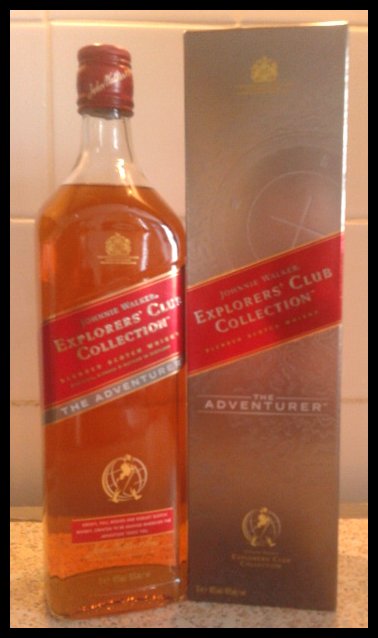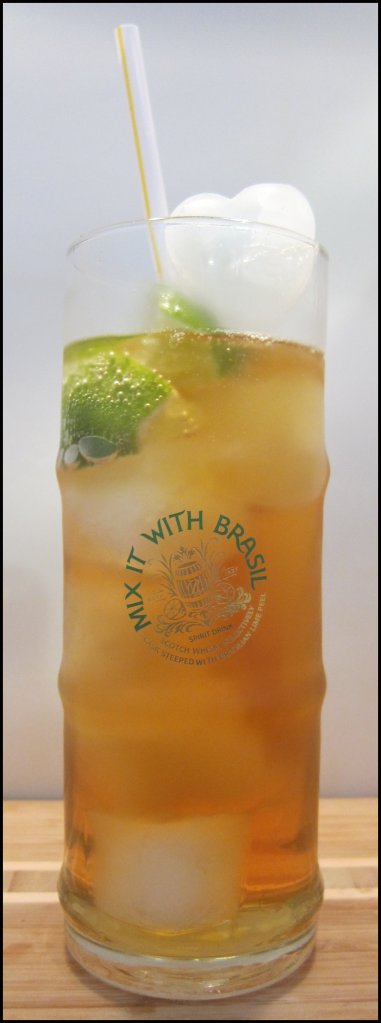Today’s review, which comes after far too long a break, takes a look at another whisky: one from the Johnnie Walker Explorers’ Club Collection, a series inspired by the journeys of those who took Johnnie Walker across the world. Available via travel retail, you might have spotted these as you explored the whisky sections of Duty Free shops.
DTS and I first encountered The Adventurer before a trip to America a couple of years ago and we were a little confused at its store placement: very much apart from the other Explorers’ Club whiskies and with little information available on it. Intrigued, we bought a bottle. That was a few years (and bottles) ago.

On its own
Nose: A saline, almost briney smokiness to start, with notes of tobacco, dry wood chips, and echoes of pineapple. Lovely spiced notes build up over time.
Taste: Very soft on the tongue, but with more force of flavour on the palate afterwards. There is a pleasant smokiness, before lasting notes of dry, not tart pineapple, light wood, and chilli, then sweeter spice with more smoke on the finish. A lovely dram that, personally, I think is perfectly halfway between the Red and Black Labels.
Rob Roy
Pleasantly dry, but the Rosso comes through well. Wisps of smoke are followed by lots of complex herbal notes. The finish remains lovely and dry, with notes of dark liquorice and a hint of berries. Finally, there is a clean, light, and woody smokiness.
Old Fashioned
The Adventurer makes an unusually sharp, almost bitter Old Fashioned that makes a wonderful aperitif. Subdued honey notes are followed by the smoke and spice. Like the Rob Roy, its finish is very dry, but full of smoky flavours, along with a little lime and vanilla.
Whisky Soda
Exceptionally dry, this is a refreshing, grown up drink. The soda water lengthens the whisky well, without masking any of its flavours. To start, there is dry vanilla, before a flash of sweeter smoke, then more charred notes that linger on a refreshing, woody finish.
Whisky Ginger
Again, this works well, but produces a much sweeter drink than the others. It is creamy, too, with lots of vanilla and just a dash of smokiness – more than you’d get with the Red Label, but not as much as with the Black Label. The finish is long, with solid notes from both the ginger and the whisky’s oak notes.
It is worth noting that the Explorers’ Club Collection covers a broad price range, but The Adventurer is the cheapest, at around £32 for a litre in Duty Free. It can be found for around £40-45 in the UK. Given the combination of price point and the international theme of the collection, we decided to try a few additional, unusual long drinks alongside our normal line-up.
with Coconut Water
This is an unexpectedly brilliant, refreshing drink. The coconut water adds the extra sweetness and creaminess that The Adventurer holds back on, resulting in smooth notes of pineapple and light coconut that fade into smoke, dry apple, and oak on the finish. Exceptionally easy to drink, especially in warmer weather.
with Ting
These flavours, again, go surprisingly well together – there is bright, vibrant, citrus (lemon and grapefruit) that flows seamlessly into the light smokiness of the whisky. The finish has notes of vanilla and pineapple, and a continued stream of smokiness.
with Fentiman’s Curiosity Cola
Intrigued at how well some of these combinations were turning out, we decided to try The Adventurer up against one of my favourite (and most flavourful) soft drinks: Fentiman’s Curiosity Cola. The result? A tasty drink with great structure and body. Not too sweet, there’s a dry woodiness to start, that is quickly swept up in the complex, herbal flavours from the cola. The Adventurer’s smokiness appears on the finish – soft to start, but gradually increasing – and works very well with the more medicinal notes of the mixer.
In Conclusion
The Adventurer is a great addition to the Johnnie Walker line-up. With its light texture, but combination of distinct smokiness, dry pineapple, and spiced notes, it makes for a whisky that is both easy to sip – sitting midway between the Red and Black Labels in taste – and works exceptionally well in mixed drinks. A firm favourite in our household.
— Mrs. B.

































